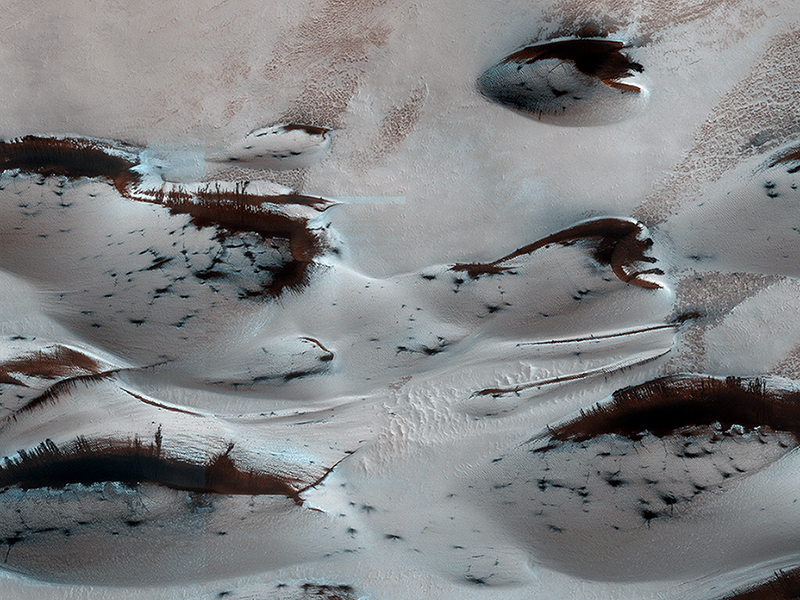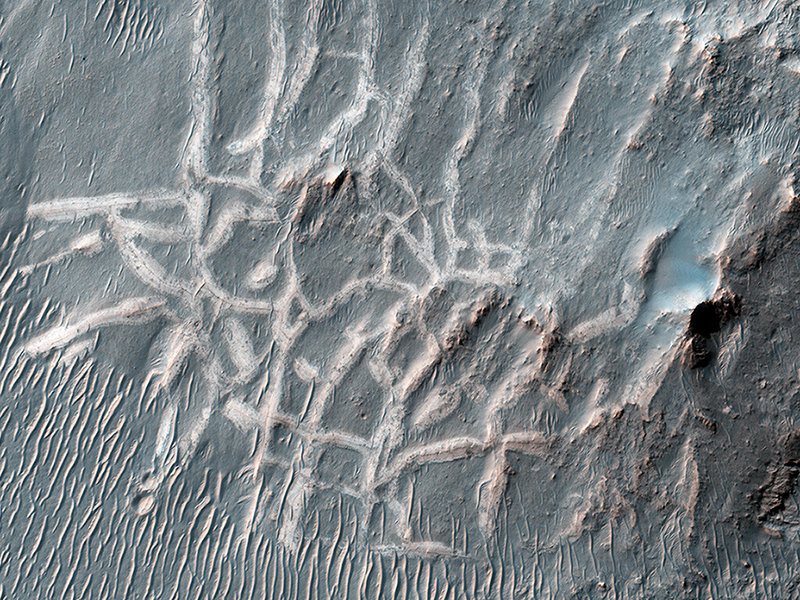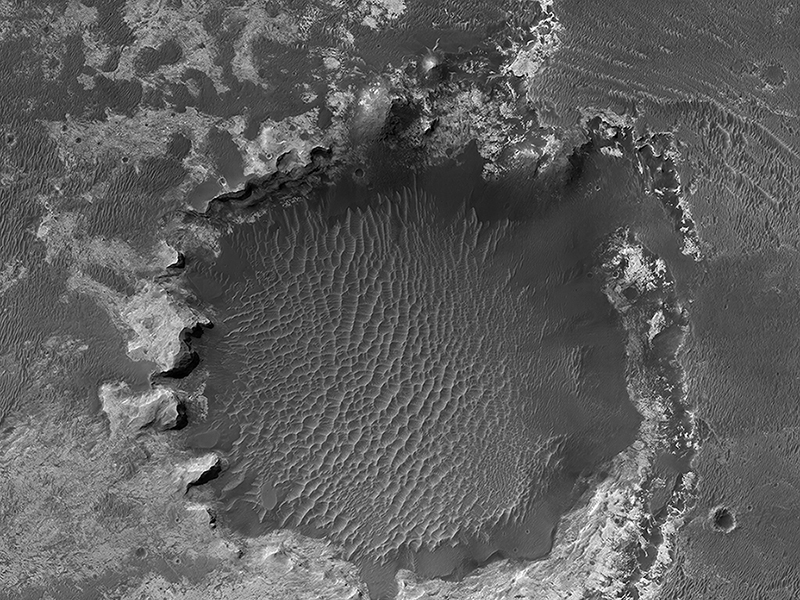Candy Hansen wrote:Sand Dunes in Spring (ESP_035033_2635) (HiClip)
Mars’ northern-most sand dunes are beginning to emerge from their winter cover of seasonal carbon dioxide (dry) ice. Dark, bare south-facing slopes are soaking up the warmth of the sun.
The steep lee sides of the dunes are also ice-free along the crest, allowing sand to slide down the dune. Dark splotches are places where ice cracked earlier in spring, releasing sand. Soon the dunes will be completely bare and all signs of spring activity will be gone.
Shane Byrne wrote:Don't Get Lost in the North Polar Ice Cap (ESP_035295_2670) (HiClip)
A bright ice cap of frozen water covers the North Pole of Mars. In the winter, thin coverings of carbon dioxide and water frost covers this area and these frosts finally disappear at the end of the Martian spring season.
In this image, the winter frosts are about to disappear and we can begin to see the surface features of the ice. The ice cap would be a bad place to get lost: it's one of the smoothest, flattest places on Mars so there are no landmarks visible. The surface features are gently rolling hummocks (or small mounds) and hollows about a meter (3 feet) in height and about 20 meters (60 feet) across. This monotonous landscape continues for hundreds of kilometers in every direction with this same repeating pattern.
Scientists do not know what makes this pattern so uniform over such large distances; we acquire HiRISE images like this one to look for small differences in these icy features from one place to another. Understanding this surface can help us understand the current climate and meteorological conditions at the North Pole of the Red Planet.
Ginny Gulick wrote:Many Small Interesting Ridges in Erythraea Fossa (ESP_035409_1525) (HiClip)
These light-toned ridges are found in a large fracture located east of Holden Crater and form a curious box-like pattern.
A hair-line fracture runs along the axis of each ridge line. The overall pattern spans several hundred meters across and individual ridges are several meters wide. Scientists are not sure how they formed yet, but some possible explanations suggest that mineral-rich ground water flowed out of the hairline fractures and deposited minerals at or near the surface as the water evaporated.
In addition, these minerals may have formed a cement along the fractures, making these patterns more resistant to subsequent erosion by wind or other processes. The resulting cemented ridges then stand high above the surrounding plains.
Ginny Gulick wrote:A Crater Straddling Two Terrain Units (ESP_035421_1810) (HiClip)
An approximately 1-kilometer impact crater located in northern Sinus Meridiani has formed along the boundary of two different terrain units. The western part of the crater has formed along a unit consisting of wind-blown basaltic materials that overlie light-toned units exposed in the crater wall.
To the east is a shallow circular depression several kilometers across that consists of multiple layers of light-toned deposits that have been eroding away. These deposits are dark in THEMIS night-time infrared and bright in day-time infrared images, suggesting that they are relatively fine grained and largely devoid of rocky materials.
Dark, fine-grained basaltic wind-blown material partially mantles these units and forms dunes throughout the region. Along the eastern rim region, the impact crater is eroding back into the terrain, forming scalloped inlets in the crater rim and re-exposing the multiple layers of light-toned deposits. Terracing is common along the eastern slope of the crater.
Turning our attention to the the western slope, we see that the rim is eroding back into the terrain more evenly. Although this slope lacks a scalloped appearance, the erosion of the top units appear to be more even and at a faster rate than the underlying light-toned deposits. Dark wind-blown basaltic dunes line the floor of the crater. Some possible explanations for the origin of these light-toned deposits are that they are altered volcanic ash or ancient lake deposits.
Credit: NASA/JPL/University of Arizona
<< Previous HiRISE Update



